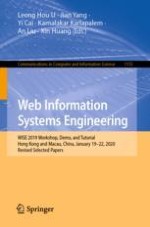2020 | Buch
Web Information Systems Engineering
WISE 2019 Workshop, Demo, and Tutorial, Hong Kong and Macau, China, January 19–22, 2020, Revised Selected Papers
herausgegeben von: Leong Hou U, Prof. Jian Yang, Yi Cai, Kamalakar Karlapalem, An Liu, Xin Huang
Verlag: Springer Singapore
Buchreihe : Communications in Computer and Information Science
